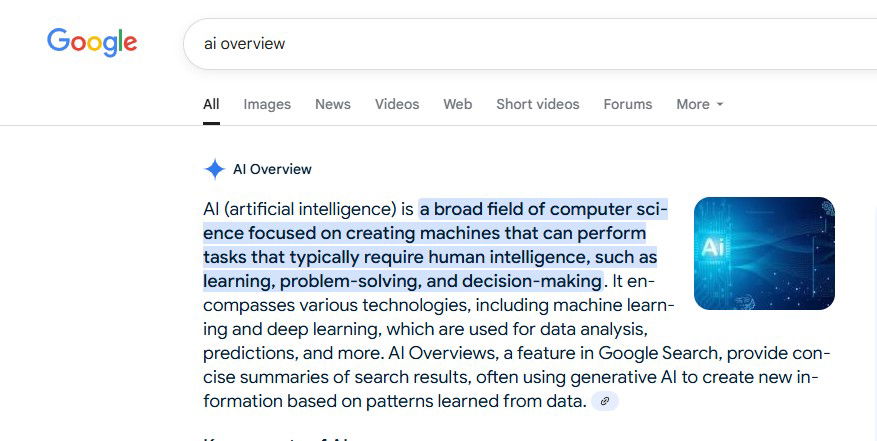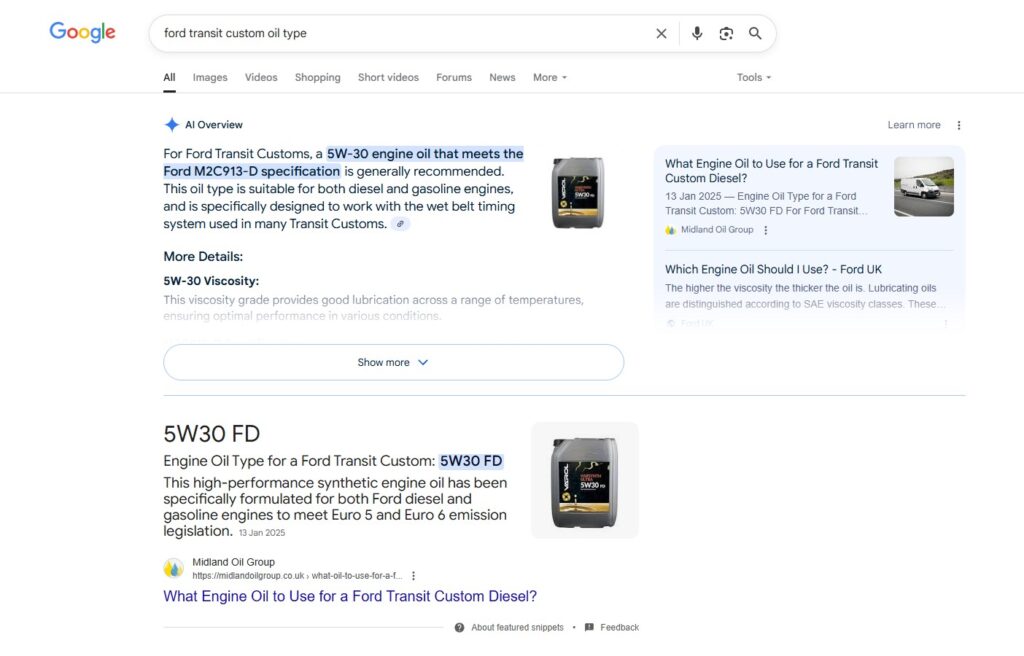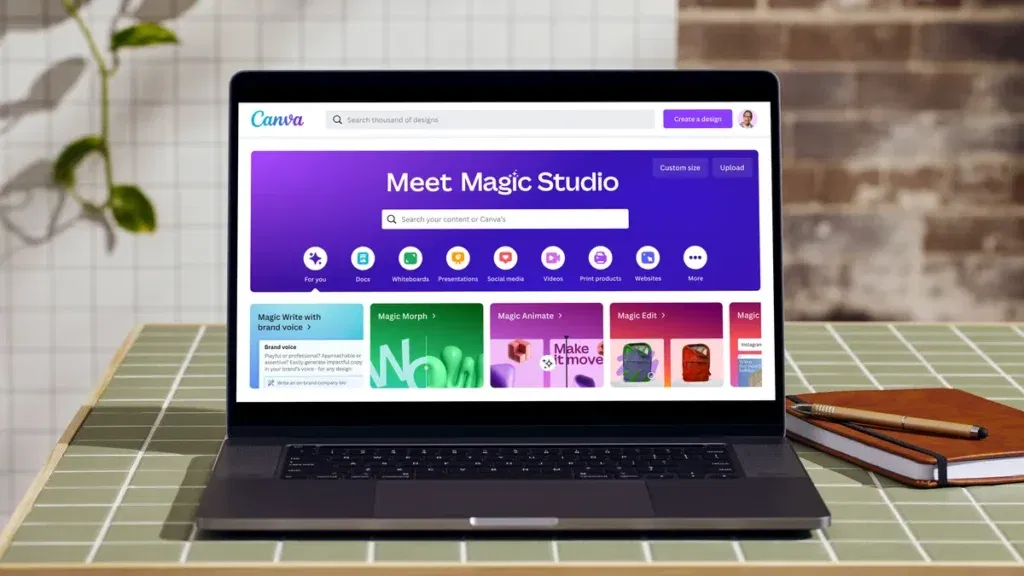
The world of click and search is quietly undergoing a period of radical transformation. AI is everywhere, and search engine are now leveraging generative AI to optimise how information is sourced and presented to search engine users.
For businesses and marketers, this is both a challenge and an opportunity. In this blog, we’ll breakdown how to optimise for AI overviews with our top 7 SEO tips to ensure you don’t get left behind by the AI revolution.
What are AI Overviews?

AI overviews are search engines’ attempt at bringing the world of click and search into the new AI-dominated era. Giants such as Google recognised that people are no longer just searching a question and clicking on various web links to get their answers.
Today, internet users are increasingly turning to ChatGPT, Gemini, and other AI models for easily digestible, bite-sized answers. Search engines have now began to capitalise on this by integrating generative AI tools into their platforms.
For example, Google is now using their AI platform Gemini to scan and synthesise large swathes of information from a wide range of sources to provide generated responses. In theory, this should provide search engine users with quick, comprehensive answers, satisfying their search queries and keeping them coming back for more.
Whilst AI overviews are a god-send for those who hate trawling through websites, AI overviews pose a unique challenge to businesses.
Businesses are no longer competing for just the top spot on Google – they’re now vying for the lucrative ‘position zero’.
The Importance of AI Overviews for SME’s & Local Businesses
Optimising your website for both search engines AND AI Algorithms is fast becoming an essential aspect of effective SEO strategy. Optimising your website for Google’s AI Overviews at the top of Search engine results pages (SERP’s) is now crucial for ensuring that your brand is maintaining maximum online visibility.
Fail to the make the cut, and not only might Google consider your website to be too low in E-E-A-T signals (more on this later), but you will also have less chance of driving organic traffic through to your site. These overviews effectively take the top spot on Google, so it’s important not to underestimate their value.

What’s interesting about AI overviews, is that generative AI actually selects information slightly differently compared to how search engines would traditionally go about sourcing information.
Rather than basing its selection process entirely on SEO factors such as authority score, keyword density, and user-friendliness, AI algorithms rely more on general information processing.
This means that your website doesn’t need to be all-singing, all-dancing to appear in AI overviews—which should prick the ears of small businesses that don’t have fully formed websites yet.
AI models prioritise information that is well-explained and contextually relevant, over traditional SEO ranking factors (although these still play a role).
So long as your website offers credible, informative, and authoritative content, it stands a good chance of being selected.
This represents a massive opportunity for local businesses and SME’s to get their foot in the door. It provides them with a platform to trump even the biggest of competitors if they get their content strategy right.
So long as they can provide fact-based, information-rich answers to users’ search queries, they stand a great chance of being selected nabbing position zero. Even a David can beat a Goliath on his day.
Here at Chameleon, we’re helping SME’s and local bushiness take full advantage of this emerging trend. We’re leveraging strategic content marketing to effectively target search engine algorithms, search engine users AND AI Algorithms, pipping our clients’ competitors to the new ‘top spot’ on Google. Here’s how we’re doing it:
7 SEO Tips: How To Optimise for AI Overviews
1. Become a Topical Authority, Not a Generalist
Despite selecting its information differently, AI algorithms still priortise high-quality, fact-based content that meets the search intent of users.
With so much information to choose from, the best chance you have of standing out from the crowd is by offering unique, genuinely insightful answers to search users’ queries. AI algorithms are much less likely to select your website for its syntheses if you’re simply regurgitating what’s already out there.
Try to bring something new to the equation. This could be:
- Industry knowledge: Be sure to leverage your unique industry knowledge and insights to answer search engine users’ burning questions. This can include anecdotes, case studies and lived experiences – anything that signals to algorithms that you have the answers they’re looking for.
- Keep it fresh: Try to offer nuanced insights that challenges the narrative (so long as its backed by evidence). This can help signal your brand as a thought leader in your field, communicating to AI algorithms that your information is valuable and worthy of selection.
- Go deep, not wide: Attempt to offer greater value than competitors by delving deeper into topics, including info-graphics, FAQ’s, and detailed breakdowns. This helps communicate to AI that you have topical authority compared to competitors. Being the go-to expert in one area beats being mediocre across many.
- Stick to your chosen subject area: Focus on offering specialist knowledge in one particular field, rather than multiple. This helps to maintain a consistent content theme to strengthen your authority signal.
2. Double Down on E-E-A-T Signals
Following on from this, it’s important to establish your brand as an authoritative voice in your chosen field. Despite relying less on traditional SEO ranking factors, AI algorithms are still highly trained to identify information that demonstrates E-E-A-T.
No, this isn’t the sequel to a 1982 Steven Spielberg film; it’s rapidly becoming a cornerstone of digital marketing strategy. E-E-A-T stands for Experience, Expertise, Authority, Trust. Just like Google’s algorithms, they attempt to use these signals to verify credible sources of information, before then using these sources to synthesise their answers.
This means – especially after Google’s March Core Update – that it’s never been more important to optimise your site for these signals. Here’s how to do it:
- Experience: Offer personal anecdotes, tips, and even emotive case studies. This not only helps to communicate to AI algorithms that your content is unique, but it also makes it believable for search users. People enjoy reading content written by real people. Keeping your text as human-centric helps to highlight your unique industry experience, providing real insight into a particular issue or topic that users may find incredibly helpful.
- Expertise: Include author bios, if possible, with credentials and real-world experience. Also be sure to back up your content with citations, examples, and statistics that help demonstrate your point. AI is more likely to select your content if it appears credible and expertly written.
- Authority: As outlined above, be sure to regularly publish original insights, making use of industry knowledge to offer nuanced perspectives. Be sure to provide clear, evidence-based answers that establishes your authority in your field. This helps your website to stand out from the crowd, signalling to AI algorithms that your site is a reliable source of information.
- Trust: Use clear, consistent branding to distinguish your website. Be sure to also leverage Google Reviews and testimonials, and acquire backlinks from local businesses and other credible organisations. This helps to communicate that your site can be trusted by Algorithms. Also be sure to audit your backlinks to ensure that you’re not associated with any toxic links that may harm your trust score.

3. Strike a Balance Between Clarity and Depth
You want to make it as easy as possible for AI algorithms to select your content. If there are particular search queries that you feel haven’t been adequately answered by your competitors – aim to answer them more concisely!
Like humans, AI algorithms can get lazy. If you can provide a clear, concise and authoritative answer to a particular search query, AI algorithms will likely favour your content over others, fast-tracking you to the top of its overview.
It’s important to strike the right balance between conciseness and depth however. If your content is too thin, AI algorithms may see it as shallow and unhelpful content. But make it too long and convoluted, and and you give the algorithms a harder job of finding your information.
Try to strike the right balance between going into depth about a topic, but still prioritising short, precise answers to particular queries.
For example, start with a clear, concise snippet that aims to answer a particular search query as succinctly as possible—using just a couple of lines. You can then delve deeper into the topic with stats, breakdowns and analysis after. See below how we fast-tracked our client Midland Oil Group to position zero using this method.

4. Identify Niche Queries To Target
AI overviews can be extensive, breaking down issues and topics at length. Algorithms will typically identify it’s ‘top 3’ sources to show first, before then relying on auxiliary sources to further beef out its responses.
This means there’s additional, albeit smaller opportunities, to get your site to appear in overviews. These can be valuable for increasing your site’s online visibility, even if you don’t quite make the cut of the top 3. Here’s how you can do it:
- When writing content, try to answer multiple queries that are closely related to the main topic, without diluting the page’s main intent.
- Use sub-headings, like a H3-tag, to indicate to algorithms that you’re about to provide an answer to a niche, subsidiary query related to the main topic.
- If done diligently, this won’t dilute the intention of your piece, and will instead support it, further establishing your authority on the topic and increasing your chances of appearing in AI overviews. See an example from our SEO client Severn Access below.

5. Optimise Content for Both AI and Search Users
AI prioritises clear, easily digestible content. Optimising the structure of your content is therefore vital for helping algorithms to decipher your content. Having a clear, logical structure will help communicate to algorithms that you have all the answers its looking for, making its job as easy as possible.
Meanwhile, having a clear structure will also help boost the user-friendliness of your page, keeping your website users engaged. If your content is too messy, with an illogical or convoluted structure, it’s less likely to be cited.
Here’s How to Optimise for AI Overviews:
- Use clear subheadings in the form of H-tags (H1, H2, H3), ideally in sequential order, which are optimised for keywords.
- Include bullet pointed lists frequently, making information as clear and bite-sized as possible.
- Keep paragraph lengths short and readable, no streams of information that obscures your points.
- Include FAQs, glossaries, or definitions for complex terms (this helps both users and AI algorithms, further establishing your authority).
6. Use Structured Data and Schema Markup
AI algorithms (and search engines) rely on structured data to accurately assess your content. This helps them to better understand the context and structure of your content, making it more likely to appear in AI summaries and featured snippets. Here’s what to do:
- Add schema mark-up data for key content types, including Local Business schema, Services, FAQ’s, Products, and Reviews schema.
- Validate your markup using Google’s Rich Results Test to make sure your schema can be read; errors can prevent your content from being shown in rich results.
7. Optimise for AI Crawlers
Many AI tools actively browse the open web to retrieve content, so it’s important to optimise the crawlability of your site. Much like with regular search engine algorithms, if your site isn’t easy to access or understand, you’re missing out on a chance to be included in their responses.
Here’s how to optimise for AI overviews using crawlability:
- Remove crawl barriers: Double-check that important pages aren’t being blocked by robots.txt or ‘noindex’ tags.
- Optimise for speed and mobile: AI tools will favour fast, mobile-friendly pages, so it’s always a good idea to keep those load times down.
- Use canonical tags correctly: Communicate to algorithms which content you would prefer them to choose if you have very similar or duplicate pieces of content on your site.
How To Optimise for AI Overviews: Final Thoughts
Don’t Just Rank—Become an Authority
As AI continues to reshape how people find and consume information online, your SEO strategy needs to evolve with it. The brands that will thrive in the new search landscape aren’t just optimising for ranked positions – they’re learning how to optimise for AI overviews.
By prioritising your E-E-A-T signals, structuring and wording your content for both humans and AI algorithms, and becoming a genuine authority in your niche, you can give your website the best possible chance of being featured by both search engines and AI models.
This shift doesn’t mean the end of traditional SEO – in many ways, it is a reaffirmation of it. However, if you’re a local business or SME, it’s a massive opportunity to leapfrog competitors and get seen online. It’s now more important than ever to carefully consider the form, style and structure of your website’s content.
Still feel lost after reading this blog? Speak to the experts at Chameleon today. We’re leading the way in helping local businesses and SME’s optimise their sites for AI overviews using strategic content marketing, ensuring they don’t get left behind by the new AI revolution. Don’t just rank, become a digital authority with Chameleon Web Services today. Get in touch with us.
Share This Content
More Chameleon Insights
- Digital Marketing
Google Search Console Adds New Branded Queries Filter
Google Search Console has introduced a brand new feature: the branded queries filter. This latest addition provides users with a new way to filter their website performance. The feature is designed to help you understand your traffic better and what’s driving users to your website by allowing you to differentiate between query types. What is…
12 Dec 2025
- Digital Marketing
How To Optimise For Google’s E-E-A-T Signals
In this blog, we'll explain what Google E-E-A-T signals are, and how you can optimise your website for greater trust and authority.
28 Nov 2025
- Digital Marketing
What Is Generative Engine Optimisation? (GEO)
What is GEO? In this blog, we delve deep into what Geneartive Search Optimisation is, and how it's shaping the future of digital marketing.
17 Nov 2025
- Digital Marketing
How AI Is Changing Content Creation in 2025
Discover how AI is changing content creation in 2025 with Chameleon Web Services. Find out about AI copywriting, social media & video form in our full guide.
30 Oct 2025
- Digital Marketing
- Social Media
- Web Design
Top 10 Canva Tips – What Every Content Creator Should Know
Discover Chameleon Web Services top 10 Canva Tips for content creators. Design eye-catching graphics with ease. Perfect for beginners & pros alike.
16 Oct 2025
- Digital Marketing
Google Removes the ‘&NUM=100’ Parameter: What it Means for Digital Marketing
Google has removed the '&NUM=100' parameter, but what does this mean for digital marketing? Chameleon Web Services unpack the details and how you can adapt.
02 Oct 2025
- Chameleon Updates
- Company
Which company is best for web designing?
When searching online for the best company for web designing services, it’s easy to feel overwhelmed. With thousands of agencies offering everything from “cheap websites” to “luxury digital experiences,” how do you know which one to choose? Of course, we’d say Chameleon Web Services is the best – and here’s why. Experience That Stands the…
02 Sep 2025
- Advertising
- Car Competition
- Chameleon Updates
- Competition
- Google Advertising
- Marketing
- Prize Draw
- SEO
Car Prizes and Competitions
Car Prizes and Competitions Driving Digital Success The world of car prize draws and competitions has exploded in recent years, with names like Dream Car Giveaways, Nitrous Competitions, Omaze, and 7 Days Performance creating huge followings online. Now, with Porsche Club GB launching its very first official prize draw to win a Porsche, the market…
18 Aug 2025
- SEO
Google Ads vs Facebook Ads for Small Businesses: A Guide
Wondering whether Google Ads or Facebook ads would be better for your small business? Read our full breakdown here to find out.
08 Aug 2025
- SEO
Are Your BT Phone Lines Down? How Chameleon Help Keep Businesses Connected
Is your BT phone line not working but your internet is? Yesterday, as you may know, there was a major outage that hit the main providers such as EE, BT, Vodaphone, and more. With EE and BT phone lines not working, as imagined, this impacted millions of people across the country, customers enquiring about services,…
25 Jul 2025
- SEO
Google To Automatically Display Instagram Photos & Videos In Search Results
Starting from July 10th, 2025, Instagram will begin to automatically surface more public photos and videos from professional accounts in search engine results pages. In this blog, we'll breakdown what this means for click and search, and how you capitalise on this emerging trend.
27 Jun 2025
- Digital Marketing
Huel: A Marketing Case Study
Learn how Huel used cutting-edge marketing techniques to take the nutrition-world by storm. Find out how you can emulate their success. Chameleon Web Services.
30 Apr 2025













